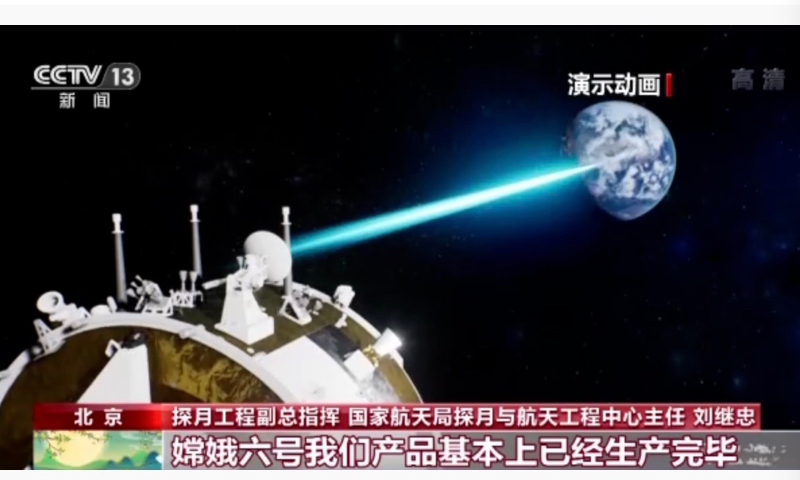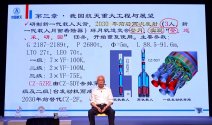You are using an out of date browser. It may not display this or other websites correctly.
You should upgrade or use an alternative browser.
You should upgrade or use an alternative browser.
China's Space Program News Thread
- Thread starter crazyinsane105
- Start date
- Status
- Not open for further replies.
They need a rocket and the vehicle. Neither are in service. I do not see it happening any time soon.
Unless they plan to build themselves a space craft while in LEO via multiple LM-5 launches. AFAIK, the manned vehicle for the Moon have yet to be unveiled. I believe only computer generated images were posted.
I think those would be the test flight for the rocket and vehicle, not real manned landing mission.
I think those would be the test flight for the rocket and vehicle, not real manned landing mission.
Anyway they should proceed at their own pace and not rush things.
China’s Phase-4 lunar probe mission approved by state, expected to build basic structure for Intl Lunar Research Station
By Global Times Published: Sep 10, 2022 10:41 PM

China’s Phase-4 lunar probe mission, which has gained state approval, is expected to explore the Moon’s South Pole and build a basic structure for the International Lunar Research Station. Photo: screenshot of demo animation of the mission
China’s Phase-4 lunar probe mission, consisting of the Chang’e-6, -7, and -8 to be carried out successively in 10 years, has obtained state approval and is proceeding smoothly, the China National Space Administration (CNSA) announced on Saturday. The mission is hoping to explore the Moon’s South Pole region and build a basic structure of the International Lunar Research Station (ILRS).
The Chang’e-6 probe, which has served as a backup for Chang’e-5 with a sample retrieval capability, will travel to the far side of the moon, Liu Jizhong, Director of China Lunar Exploration and Space Engineering Center, said in an interview with China Central Television (CCTV). He added that the module has been basically completed.
Liu noted that the Chang’e-7 probe is currently being developed. The mission will subsequently explore the Moon’s South Pole region, and establish a basic structure for the ILRS.
When asked why the country looks at the South Pole region for the building of ILRS, Wu Weiren, the chief designer of China's lunar exploration program, told the Global Times previously that the temperature on the far side of moon can reach -200 C and the near side can mount to 200 C, neither of which is not suitable for long-term human activities.
The South Pole region is also subject to the polar day night phenomenon, during the polar day, there would be more than 180 days of continuous daylight, which would support long-term work on the moon surface, and which explains why we intend to build the station there, Wu told the Global Times.
There may also be water in the deep pit located in the South Pole, and if any can be found there, it will be another positive factor for the sustained operation of the ILRS as well as a short-period of human exploration in the region, he added.
According to the CNSA, the exploration of the South Pole will be completed by Chang'e-6 and -7, while Chang'e-8 will deploy some key technologies for lunar surface tests and preliminary exploration for the construction of the lunar research base.
“The purpose of our missions is to lay the foundation for building a lunar station. So there are a lot of technologies that need to be tackled, and meanwhile the resources available on the Moon needs to be surveyed, so great challenges lay ahead of us. But with our previous experiences and an excellent team, I believe we can succeed,” Liu said.
Wu added that there will be rovers, landers and leapers working in a coordinated way as part of the future ILRS and also lunar-based communication network, such as Wi-Fi, to support the long-term mission.
Quickie
Colonel
I think those would be the test flight for the rocket and vehicle, not real manned landing mission.
My guess is the test flight will be somewhat like the Orion flyby of the moon followed by automated landings of landers, rovers, and even moon station modules, and then only, manned landings.
I think that China will continue testing all the parts of a potential LM5 moon shot until they are confident about making an announcement.
From announcing the mission to carrying it out could be a short time, like 2 years only.
This ought to happen no matter what happens with LM9.
From announcing the mission to carrying it out could be a short time, like 2 years only.
This ought to happen no matter what happens with LM9.
China’s Phase-4 lunar probe mission approved by state, expected to build basic structure for Intl Lunar Research Station
By Global Times Published: Sep 10, 2022 10:41 PM

China’s Phase-4 lunar probe mission, which has gained state approval, is expected to explore the Moon’s South Pole and build a basic structure for the International Lunar Research Station. Photo: screenshot of demo animation of the mission
China’s Phase-4 lunar probe mission, consisting of the Chang’e-6, -7, and -8 to be carried out successively in 10 years, has obtained state approval and is proceeding smoothly, the China National Space Administration (CNSA) announced on Saturday. The mission is hoping to explore the Moon’s South Pole region and build a basic structure of the International Lunar Research Station (ILRS).
The Chang’e-6 probe, which has served as a backup for Chang’e-5 with a sample retrieval capability, will travel to the far side of the moon, Liu Jizhong, Director of China Lunar Exploration and Space Engineering Center, said in an interview with China Central Television (CCTV). He added that the module has been basically completed.
Liu noted that the Chang’e-7 probe is currently being developed. The mission will subsequently explore the Moon’s South Pole region, and establish a basic structure for the ILRS.
When asked why the country looks at the South Pole region for the building of ILRS, Wu Weiren, the chief designer of China's lunar exploration program, told the Global Times previously that the temperature on the far side of moon can reach -200 C and the near side can mount to 200 C, neither of which is not suitable for long-term human activities.
The South Pole region is also subject to the polar day night phenomenon, during the polar day, there would be more than 180 days of continuous daylight, which would support long-term work on the moon surface, and which explains why we intend to build the station there, Wu told the Global Times.
There may also be water in the deep pit located in the South Pole, and if any can be found there, it will be another positive factor for the sustained operation of the ILRS as well as a short-period of human exploration in the region, he added.
According to the CNSA, the exploration of the South Pole will be completed by Chang'e-6 and -7, while Chang'e-8 will deploy some key technologies for lunar surface tests and preliminary exploration for the construction of the lunar research base.
“The purpose of our missions is to lay the foundation for building a lunar station. So there are a lot of technologies that need to be tackled, and meanwhile the resources available on the Moon needs to be surveyed, so great challenges lay ahead of us. But with our previous experiences and an excellent team, I believe we can succeed,” Liu said.
Wu added that there will be rovers, landers and leapers working in a coordinated way as part of the future ILRS and also lunar-based communication network, such as Wi-Fi, to support the long-term mission.
Animation makes it look like China is blowing up the planet with a death star laser.
The slide said 3 crew on board and landing on the surface. See the texts in red circle. I assume that you read Chinese, so I don't understand how you could have interpret the slide to unmanned test (like Artimis I).I think those would be the test flight for the rocket and vehicle, not real manned landing mission.

The slide basically says that CASC can put people on the moon around 2030 in this two launch scheme, it is another question whether the political leadership will authorize to do so.
A rocket and vehicle test that you suggest can be done much earlier, that is CZ-5DY's maiden flight around 2026. Because CZ-5DY has nowhere near earth orbit to go but Moon or Mars. The new gen capsule has been tested for moon return just like Orion, so it is ready any time now.
So I would have agreed with you that manned mission may not happen around 2030 due to political reason, but I disagree that the rocket and vehicle test happens around 2030.
Last edited:
- Status
- Not open for further replies.



